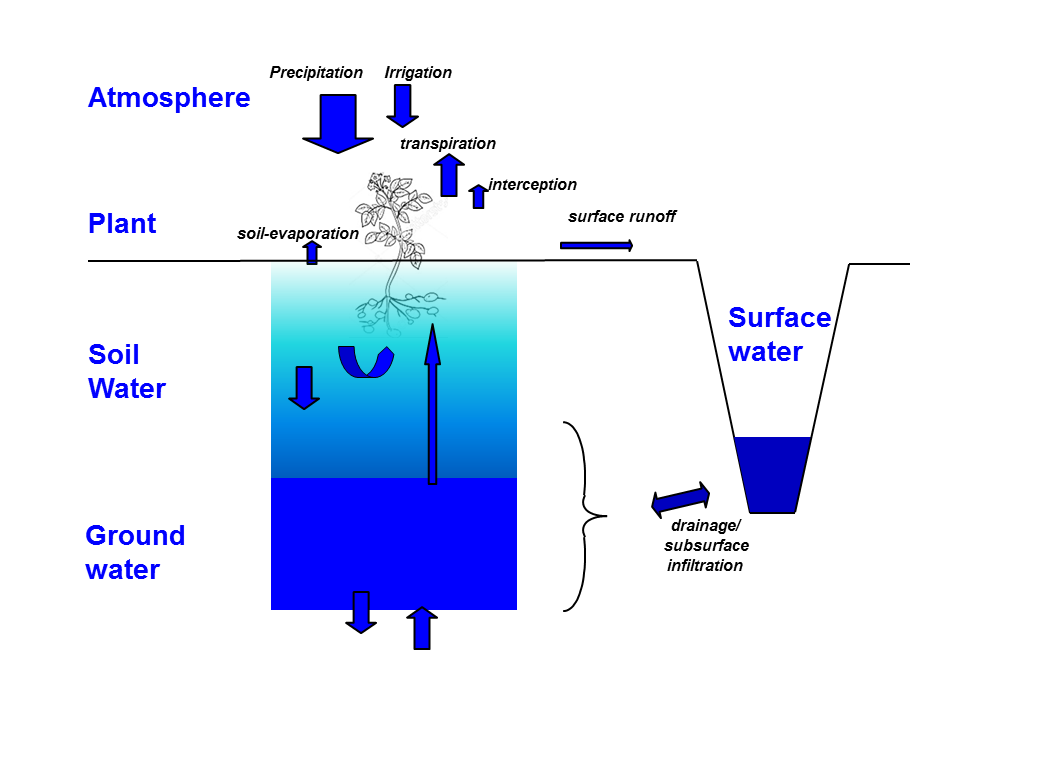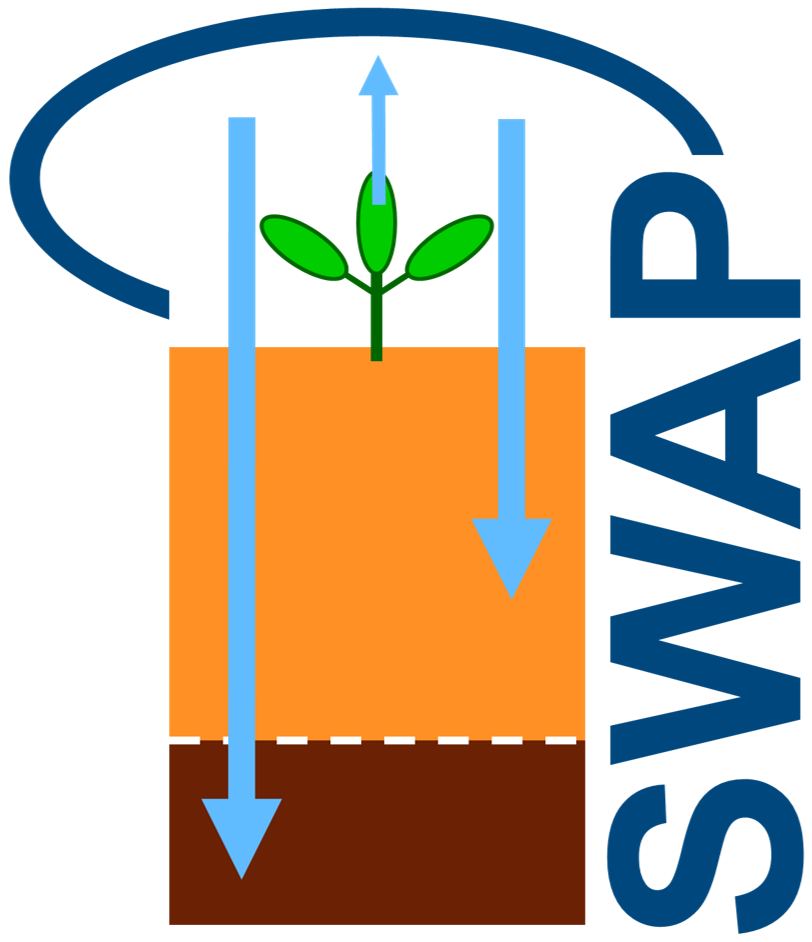Quoted from: https://swap.wur.nl/

General focus of the model
SWAP (Soil-Water-Atmosphere-Plant) simulates transport of water, solutes and heat in the vadose zone in interaction with vegetation development. SWAP has been employed to explore alternative flow and transport concepts, to analyze laboratory and field experiments, and to evaluate management options with respect to field scale water and solute movement. In the horizontal direction, SWAP’s main focus is the field scale. Published, typical examples are given by Van Dam et al. (2008) and Kroes et al. (2017) for:
- Field scale water and salinity management
- Irrigation scheduling
- Transient drainage conditions
- Plant growth affected by water and salinity
- Pesticide leaching to ground water and surface water
- Regional drainage from top soils towards different surface water systems
- Optimization of surface water management
- Effects of soil heterogeneity
SWAP also serves to generate soil water fluxes for pesticide and nutrient models. The model can be used to explore new flow and transport concepts for agro- and ecohydrology and on the analysis of laboratory and field experiments.
General context of use
The SWAP model has a wide range of users:
- Basic research: analysis of laboratory and field experiments and exploration of new flow and transport concepts for agro- and ecohydrology;
- Applied research: irrigation and water management alternatives, precipitation excess during winter (relevant e.g. for nitrate and pesticide leaching)
- Decision support: water management strategies at various scales, integral part of PEARL model (EU-level legislation of pesticides), ANIMO (nutrient cycle and leaching at field scale) and STONE model (national Dutch instrument for nutrient analysis from top soil to surface water)
- Educational and training: international training courses were given in the Netherlands, Poland, South Africa, Russia and Brazil.
History of the model
The soil hydrological model SWAP has a history of more than 40 years. The first version (called SWATR) was developed by Reinder Feddes and colleagues in The Netherlands and published in 1978. During it’s history regularly updates were spread with derived acronyms SWATRE, SWACROP, SWAP93, and SWAP: Feddes et al. (1978); Belmans et al. (1983); Wesseling et al. (1991); Kabat et al. (1992); Van den Broek et al. (1994); Van Dam et al. (1997); Kroes et al. (2001; 2003; 2008). The previous standard Internet version was published as SWAP3.2.36 by Kroes et al. (2009). The current version is SWAP4.
Systems, sub-systems, mechanisms considered in the conception of the model
SWAP is a computer model that simulates transport of water, solutes and heat in variably saturated top soils. The program is designed for integrated modeling of the Soil-Atmosphere-Plant System. Transport processes at field scale level and during entire growing seasons are considered. System boundaries at the top are defined by the soil surface with or without a crop and the atmospheric conditions. The lateral boundary simulates the interaction with surface water systems. The bottom boundary is located in the unsaturated zone or in the upper part of the groundwater and describes the interaction with regional groundwater.
Concepts, modeling formalism
The SWAP model simulates physical processes related to: soil water flow, soil heat flow, solute flow, crop growth, macropore flow and interaction with groundwater and surface water systems. The modeling concepts of these processes are summarized below.
- Soil water flow: The versatile Richards' equation is applied integrally for the unsaturated-saturated zone, with possible presence of transient and perched groundwater levels. Due to its physical basis, the Richards’ equation allows the use of soil hydraulic functions from databases and simulation of all kinds of management options. Hysteresis of the retention function can be taken into account. Root water extraction at various depths in the root zone is calculated from potential transpiration, root length density and possible reductions due to wet, dry or saline conditions.
- Soil heat flow: Soil temperature may affect the surface energy balance, soil hydraulic properties, decomposition rate of solutes and growth rate of roots. Combination of a one-dimensional soil heat flux and the equation for conservation of energy yields the differential equation for soil heat flow. This equation can be solved analytically or numerically.
- Solute flow: SWAP simulates convection, diffusion and dispersion, non-linear adsorption, first order decomposition and root uptake of solutes. This permits the simulation of ordinary pesticide and salt transport, including the effect of salinity on crop growth. SWAP is able to simulate the water residence time in the saturated zone analogous to mixed reservoirs. In case of detailed pesticide transport or nutrient leaching, daily water fluxes can be generated as input for other transport models, such as the pesticide model PEARL and the nutrient model ANIMO.
- Crop growth: Crop growth can be simulated by a module based on the code WOFOST. The processes considered include rate of phenological development, interception of global radiation, CO2 assimilation, biomass accumulation of leaves, stems, storage organs and roots, leaf decay and root extension. The assimilation rate is affected by water and/or salinity stress in the root zone. If simulation of crop growth is not needed, the user should prescribe leaf area index, crop height and rooting depth as a function of development stage.
- Macropore flow: Macroporosity can be caused by shrinking and cracking of soil, by plant roots, by soil fauna, or by tillage operations. The macropore module in SWAP includes infiltration into macropores at the soil surface, rapid transport in macropores to deeper layers, lateral infiltration into and exfiltration out of the soil matrix, water storage in macropores, and rapid drainage to drainage systems. The macropores are divided in a main bypass domain (network of continuous, horizontal interconnected macropores) and an internal catchment domain (discontinuous macropores ending at different depths). The internal catchment domain causes infiltration of macropore water at different, relatively shallow depth. In addition, the macropores are divided in static and dynamic volumes. The dynamic volumes depend on shrinkage characteristics.
- Surface water systems: Drainage to or infiltration from surface water systems is calculated with 2-dimensional drainage equations, which allow evaluation of drainage design. The user may also specify a drainage resistance or tabular values of the drainage flux as a function of groundwater level. The groundwater system can be modeled at the scale of a subregion with different surface water systems and options for surface water management. Drainage/subsurface water discharged towards surface water systems can be simulated with different residence times.
Architecture and modules of the model
SWAP consists of clearly defined modules for soil water flow, soil heat flow, solute transport, crop growth, macropore flow and interaction with groundwater and surface water systems. An extensive description of SWAP4 is given by Kroes et al. (2017).
Policy variables & intervention measures
All policy measures taken are related to water management issues. Examples are:
Building the model
The model input parameters for soil hydrology and crop growth are described by Kroes et al.(2017)
The model input parameters for soil-N, Soil-C and crop-N are described by Groenendijk et al.(2016)
A sensitivity analysis was carried out by Finke et al. (1996) and Wesseling et al. (1998).
- Calibration and validation
The model is distributed with a basic data set. As SWAP is a field scale model, most of the input parameters are clearly defined and can be measured separately. Input parameters may also be determined by inverse modeling. Documented experience is available on automated calibration using the PEST/SWAP combination, validation procedures and validation examples (Van Dam et al, 2008).
The model output parameters are described by Kroes et al. (2017).
Strengths and limitations of the model
Water flow and solute transport in top soils are important elements in many environmental studies. The agro- and ecohydrological model SWAP (Soil-Water-Plant-Atmosphere) has been developed and is strong in simulation of simultaneously water flow, solute transport, heat flow, macropore flow and crop growth at field scale level.
For detailed pesticide and nutrient flow combination other transport models such as PEARL and ANIMO are recommended.
Application at a regional scale within a GIS-environment requires additional features that are not standard distributed with the model.
SWAP adheres to the open source philosophy. This allows other research teams to integrate the model into all kinds of Decision Support Systems. This has been done at various occasions (e.g. the PEARL team, http://www.pearl.pesticidemodels.eu/home.htm )
Recent versions of the model are distributed without a Graphical User Interface.










